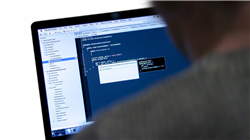University certificate
The world's largest faculty of information technology”
Introduction to the Program
Thanks to this 100% online Professional master’s degree, you will use Front-End Web Development to significantly contribute to building strong brands and achieving online business goals"

Front-End Web Development provides a smooth and engaging user experience, which increases user retention and satisfaction. It also facilitates content accessibility, allowing websites to be usable by a wide range of people, including those with disabilities. It is also crucial for search engine optimization (SEO), as a well-built structure and responsive design improve visibility.
This is how this Professional master’s degree was conceived, which will offer a complete immersion in advanced strategies and techniques, which are essential in front-end architecture. From state management, to performance optimization and security, computer scientists will acquire practical skills to build applications that meet today's requirements and are ready for future demands. A thorough understanding of CSS architecture will also be developed.
Emphasis will also be placed on the application of best practices and standards, such as WCAG and ARIA, to ensure the accessibility of applications to all users. In addition, professionals will gain advanced knowledge in TypeScript and its integration in different work environments, including projects using frameworks, such as React, Vue and Angular.
Finally, specialized aspects such as web security, performance optimization, internationalization and testing best practices will be addressed, ensuring that graduates are equipped to develop secure, efficient and accessible applications. Likewise, they will delve into the knowledge of specific frameworks, such as React, Vue and Angular, as well as advanced techniques for responsive design and optimization for mobile devices, including Progressive Web Apps.
In this sense, TECH has implemented a 100% online and totally flexible academic degree, to the point that students will only need an electronic device with an Internet connection to access all teaching materials. At the same time, you will benefit from the revolutionary Relearning methodology, which consists of the reiteration of fundamental concepts for an optimal and organic assimilation of content.
You will delve into technologies and tools relevant to the creation of attractive and functional user interfaces, such as HTML, CSS and JavaScript, through didactic materials at the forefront of technology and education"
This Professional master’s degree in Front-End Web Development contains the most complete and up-to-date program on the market. The most important features include:
- The development of practical cases presented by experts in Front-End Web Development
- The graphic, schematic, and practical contents with which they are created, provide scientific and practical information on the disciplines that are essential for professional practice
- Practical exercises where self-assessment can be used to improve learning
- Its special emphasis on innovative methodologies
- Theoretical lessons, questions to the expert, debate forums on controversial topics, and individual reflection assignments
- Content that is accessible from any fixed or portable device with an Internet connection
You'll master emerging technologies such as WebXR, Artificial Intelligence and Machine Learning, giving you a solid foundation for creating innovative user experiences on the frontend”
The program’s teaching staff includes professionals from the field who contribute their work experience to this educational program, as well as renowned specialists from leading societies and prestigious universities.
The multimedia content, developed with the latest educational technology, will provide the professional with situated and contextual learning, i.e., a simulated environment that will provide immersive education programmed to learn in real situations.
This program is designed around Problem-Based Learning, whereby the professional must try to solve the different professional practice situations that arise during the academic year For this purpose, the students will be assisted by an innovative interactive video system created by renowned and experienced experts.
You will create aesthetically pleasing and functionally rich user interfaces by applying user-centered UX design principles. Don't miss this unique opportunity that only TECH offers you!"

Specialize in the complete mastery of Front-End Web Development technologies, from the use of custom hooks to the implementation of advanced design patterns. Enroll now!"
Why study at TECH?
TECH is the world’s largest online university. With an impressive catalog of more than 14,000 university programs available in 11 languages, it is positioned as a leader in employability, with a 99% job placement rate. In addition, it relies on an enormous faculty of more than 6,000 professors of the highest international renown.

Study at the world's largest online university and guarantee your professional success. The future starts at TECH”
The world’s best online university according to FORBES
The prestigious Forbes magazine, specialized in business and finance, has highlighted TECH as “the world's best online university” This is what they have recently stated in an article in their digital edition in which they echo the success story of this institution, “thanks to the academic offer it provides, the selection of its teaching staff, and an innovative learning method aimed at educating the professionals of the future”
A revolutionary study method, a cutting-edge faculty and a practical focus: the key to TECH's success.
The most complete study plans on the university scene
TECH offers the most complete study plans on the university scene, with syllabuses that cover fundamental concepts and, at the same time, the main scientific advances in their specific scientific areas. In addition, these programs are continuously being updated to guarantee students the academic vanguard and the most in-demand professional skills. In this way, the university's qualifications provide its graduates with a significant advantage to propel their careers to success.
TECH offers the most comprehensive and intensive study plans on the current university scene.
A world-class teaching staff
TECH's teaching staff is made up of more than 6,000 professors with the highest international recognition. Professors, researchers and top executives of multinational companies, including Isaiah Covington, performance coach of the Boston Celtics; Magda Romanska, principal investigator at Harvard MetaLAB; Ignacio Wistumba, chairman of the department of translational molecular pathology at MD Anderson Cancer Center; and D.W. Pine, creative director of TIME magazine, among others.
Internationally renowned experts, specialized in different branches of Health, Technology, Communication and Business, form part of the TECH faculty.
A unique learning method
TECH is the first university to use Relearning in all its programs. It is the best online learning methodology, accredited with international teaching quality certifications, provided by prestigious educational agencies. In addition, this disruptive educational model is complemented with the “Case Method”, thereby setting up a unique online teaching strategy. Innovative teaching resources are also implemented, including detailed videos, infographics and interactive summaries.
TECH combines Relearning and the Case Method in all its university programs to guarantee excellent theoretical and practical learning, studying whenever and wherever you want.
The world's largest online university
TECH is the world’s largest online university. We are the largest educational institution, with the best and widest online educational catalog, one hundred percent online and covering the vast majority of areas of knowledge. We offer a large selection of our own degrees and accredited online undergraduate and postgraduate degrees. In total, more than 14,000 university degrees, in eleven different languages, make us the largest educational largest in the world.
TECH has the world's most extensive catalog of academic and official programs, available in more than 11 languages.
Google Premier Partner
The American technology giant has awarded TECH the Google Google Premier Partner badge. This award, which is only available to 3% of the world's companies, highlights the efficient, flexible and tailored experience that this university provides to students. The recognition as a Google Premier Partner not only accredits the maximum rigor, performance and investment in TECH's digital infrastructures, but also places this university as one of the world's leading technology companies.
Google has positioned TECH in the top 3% of the world's most important technology companies by awarding it its Google Premier Partner badge.
The official online university of the NBA
TECH is the official online university of the NBA. Thanks to our agreement with the biggest league in basketball, we offer our students exclusive university programs, as well as a wide variety of educational resources focused on the business of the league and other areas of the sports industry. Each program is made up of a uniquely designed syllabus and features exceptional guest hosts: professionals with a distinguished sports background who will offer their expertise on the most relevant topics.
TECH has been selected by the NBA, the world's top basketball league, as its official online university.
The top-rated university by its students
Students have positioned TECH as the world's top-rated university on the main review websites, with a highest rating of 4.9 out of 5, obtained from more than 1,000 reviews. These results consolidate TECH as the benchmark university institution at an international level, reflecting the excellence and positive impact of its educational model.” reflecting the excellence and positive impact of its educational model.”
TECH is the world’s top-rated university by its students.
Leaders in employability
TECH has managed to become the leading university in employability. 99% of its students obtain jobs in the academic field they have studied, within one year of completing any of the university's programs. A similar number achieve immediate career enhancement. All this thanks to a study methodology that bases its effectiveness on the acquisition of practical skills, which are absolutely necessary for professional development.
99% of TECH graduates find a job within a year of completing their studies.
Professional Master's Degree Front-End Web Development
Front-End Web Development focuses on the creation and design of the visible and accessible part of a website or application. This aspect is crucial to ensure an optimal and engaging user experience. With the rise of web technologies and the demand for dynamic and responsive user interfaces, this discipline has become a must-have skill for technology professionals. Do you want to become an expert in the field and take your skills to the next level? ThisProfessional Master's Degree in Front-End Web Development created by TECH Global University offers you a complete and cutting-edge educational experience that will prepare you to face the challenges of the modern digital world. This program, taught 100% online, will provide you with a solid foundation in the fundamentals of web development, as well as the most modern technologies and tools used in the industry. You will learn how to use languages such as HTML, CSS and JavaScript to create interactive and attractive user interfaces, as well as how to work with popular frameworks such as React, Angular and Vue.js.
Learn everything related to Front-End Web Development
In addition to technical skills, this program also focuses on important aspects such as user-centered design, web accessibility and development best practices. This knowledge will help you create websites and applications that are not only visually appealing, but also functional and easy to use for a wide audience. TECH's hands-on approach gives you the opportunity to apply your knowledge to real projects and collaborate with classmates and faculty who are experts in the field. Upon completion of the Professional Master's Degree, you will be prepared to take on challenging and rewarding roles in the field of web development. Whether as a front-end developer, user interface designer or user experience consultant, you'll have the skills and confidence to succeed in your career. Enroll today and prepare to become a leader in creating innovative, high-quality web experiences!







